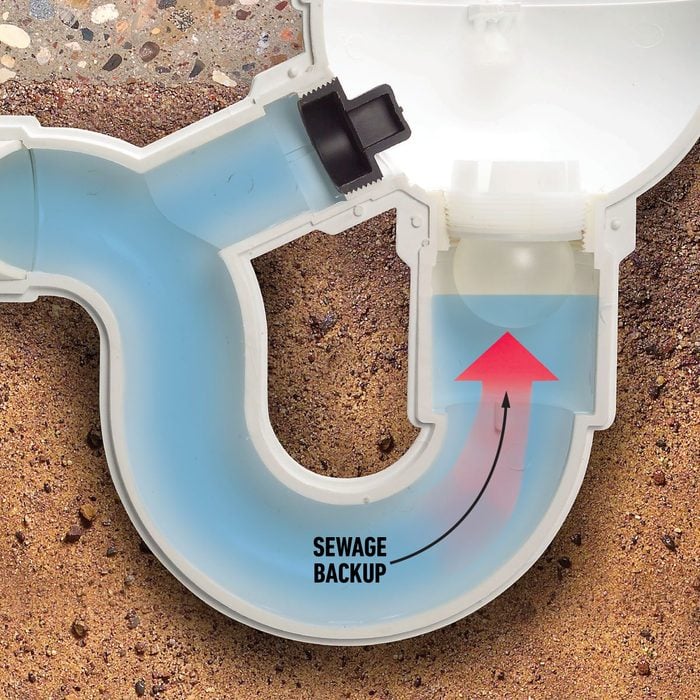
What Causes a Basement Drain to Back Up?
A basement drain can back up for several reasons, most of which are related to issues with your home’s plumbing system or external factors like heavy rainfall. Here are the most common causes:
1. Clogged or Blocked Drains
One of the most common causes of a basement drain backup is a clogged or blocked drain. Over time, debris such as dirt, hair, soap scum, and grease can accumulate in the drain pipes, causing a blockage that prevents water from flowing properly. If the blockage is severe, it can cause water to back up through the basement drain.
2. Tree Root Intrusion
Tree roots are another common culprit for basement drain backups. Roots from nearby trees can grow into your sewer lines, cracking or blocking the pipes and preventing wastewater from draining properly. When the sewer line becomes blocked by tree roots, it can cause water to back up into your basement.
3. Heavy Rainfall or Flooding
If you live in an area that experiences heavy rainfall, your basement drain could back up due to excess water entering the sewer system. During storms, municipal sewer systems can become overwhelmed by the influx of water, causing sewage to back up into homes. This is especially common in older homes with outdated plumbing systems.
4. Sewer Line Issues
A more serious cause of basement drain backups is a problem with your home’s main sewer line. If the sewer line is damaged, cracked, or collapsed, it can cause water and sewage to back up into your basement. In these cases, the problem typically requires professional repair or replacement of the sewer line.
For more information on sewer backups and prevention, check out this EPA guide on sewer backups and overflows.
How to Fix a Basement Drain Backup

If your basement drain is backing up, it’s important to act quickly to prevent further damage. Follow these steps to address the problem and restore proper drainage:
| Step | What to Do |
|---|---|
| 1. Stop Using Water Immediately | If you notice water backing up into your basement, stop using any water fixtures in your home. This includes sinks, showers, toilets, and washing machines. Continuing to use water will only worsen the backup and could lead to further flooding. |
| 2. Clear the Drain (If Possible) | If the backup is caused by a minor clog, you may be able to clear the drain yourself. Use a plunger or a drain snake to try and remove the blockage. Be cautious when using chemicals like drain cleaners, as they can damage your pipes and worsen the problem if not used correctly. |
| 3. Check for External Blockages | If the drain isn’t clearing, check outside for any external blockages. For example, debris like leaves or dirt could be blocking your exterior drains or downspouts, causing water to back up into the basement. |
| 4. Call a Professional Plumber | If the backup persists or you suspect a larger problem, such as a broken sewer line or tree root intrusion, it’s time to call a licensed plumber. A professional plumber can inspect your plumbing system with a sewer camera and determine the exact cause of the backup. |
| 5. Clean and Disinfect the Area | Once the drain has been cleared, it’s essential to clean and disinfect the affected area. Standing water from a sewer backup can contain harmful bacteria, so wear gloves and use a disinfectant cleaner to thoroughly sanitize the area. For severe flooding, you may need professional water damage restoration services. |
If your basement has been flooded due to a drain backup, Citywide Mold Mitigation can help with expert water extraction, drying, and mold prevention services.
How to Prevent Basement Drain Backups

Preventing future drain backups is essential for protecting your home from water damage. Here are some steps you can take to reduce the risk of a basement drain backup:
1. Regularly Clean Drains and Pipes
Regular maintenance of your drains and pipes can help prevent blockages from forming. Use a drain snake or a professional drain cleaning service to remove debris before it becomes a major issue. Avoid pouring grease, food scraps, or other debris down your drains, as these can easily clog your pipes.
2. Install a Backwater Valve
A backwater valve is a device installed on your home’s sewer line that prevents sewage from flowing back into your home. This is especially useful for homes in areas prone to heavy rainfall or sewer backups. If you’re concerned about future backups, consider having a plumber install a backwater valve.
3. Address Tree Root Issues
If tree roots are causing problems with your sewer line, you may need to remove or trim the offending trees. In some cases, plumbers can use root-killing chemicals to stop the roots from growing into your pipes. For more severe cases, your sewer line may need to be repaired or replaced to prevent future blockages.
4. Improve Drainage Around Your Home
Ensuring proper drainage around your home can help prevent water from pooling near your foundation and backing up into your basement. Clean gutters and downspouts regularly, and consider grading your yard away from the foundation to direct water away from your home.
5. Use a Sump Pump
If your basement is prone to flooding, a sump pump can help protect against water damage. A sump pump works by removing water from your basement and directing it away from your home. If you already have a sump pump, make sure it’s regularly maintained and functioning properly.
For more tips on preventing basement flooding, check out this HGTV guide on basement flood prevention.
FAQ
| Question | Answer |
|---|---|
| Why is my basement drain backing up? | Basement drains can back up due to clogged pipes, tree roots in the sewer line, heavy rainfall, or damaged sewer lines. Identifying the exact cause is key to preventing future backups. |
| Can I use drain cleaner to clear a basement drain? | While chemical drain cleaners can sometimes clear minor clogs, they can also damage your pipes if used too often. For persistent or severe clogs, it’s best to call a professional plumber. |
| How can I prevent a basement drain from backing up during heavy rain? | Installing a backwater valve, ensuring proper drainage around your home, and cleaning your drains regularly can help prevent backups during heavy rain. |
| Is a backed-up drain covered by homeowners insurance? | In many cases, basement drain backups caused by sewer issues may not be covered by standard homeowners insurance policies. However, some policies offer optional sewer backup coverage. Check with your insurance provider to confirm your coverage. |
| What should I do if my basement floods from a drain backup? | If your basement floods due to a drain backup, stop using water, call a plumber, and begin water extraction as soon as possible. For large floods, contact a professional water damage restoration company like Citywide Mold Mitigation for assistance. |
If your basement has suffered water damage or mold growth due to a drain backup, contact Citywide Mold Mitigation for expert water extraction and mold remediation services.

